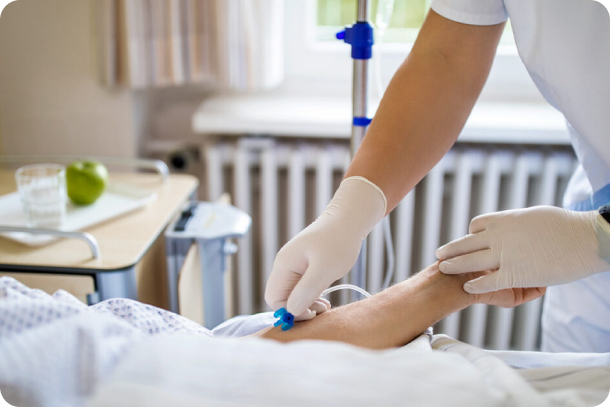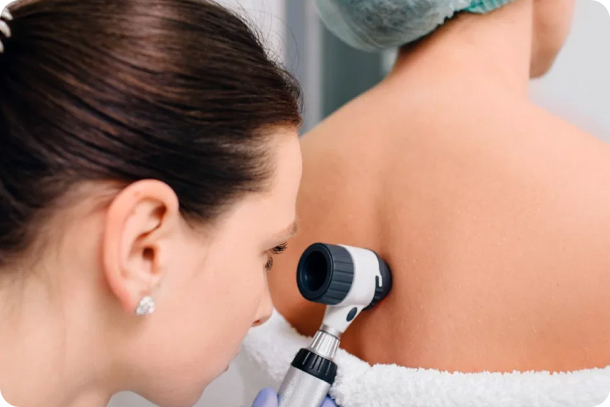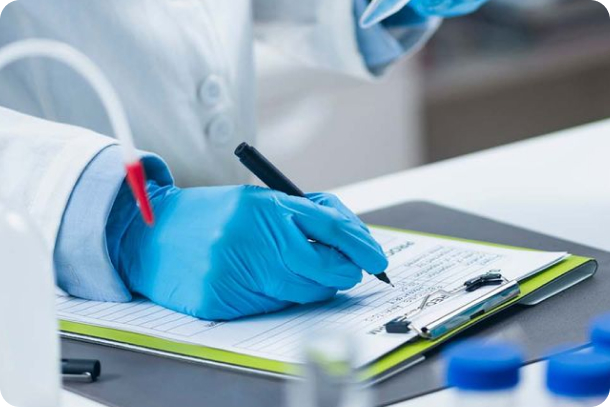
Age-related macular degeneration (AMD is a disease associated with aging that gradually destroys sharp, central vision. Central vision is needed for seeing objects clearly and common daily tasks such as reading and driving.
AMD affects the macula, the part of the eye that allows you to see fine detail. AMD advances so slowly that people notice little change in their vision. In others, the disease progresses faster and may lead to a loss of vision in both eyes. AMD is a leading cause of loss of vision in Americans of 60 years of age and older.
AMD occurs in two forms: wet and dry.
Wet AMD occurs when abnormal blood vessels behind the retina start to grow under the macula. These new blood vessels tend to be very fragile and often leak blood and fluid. The blood and fluid raise the macula from its normal plave at the back of the eye. Damage to the macula occurs rapidly.
With wet AMD, loss of central vision can occur quickly. Wet AMD is also known as advanced AMD. It does not have stages like dry AMD. An early symptom of wet AMD is that straight lines appear wavy. If you notice this condition or other changes to your vision, contact your eye care professional at once. You need a comprehensive dilated eye exam.
Both dry and wet cause no pain For dry AMD: the most common early sign is blurred vision. As fewer cells in the macula are able to function, people will see details less clearly in front of them, such as faces or words in a book. Often this blurred vision will go away in brighter light. If the loss of these light-sending cells becomes great, people may see a small-but growing- blind spot in the middle of their field of vision.
For wet AMD: the classic early symptom is that straight lines appear crooked. This results when fluid from the leaking blood vessels gathers and lifts the macula, distorting vision. A small blind spot may also appear in wet AMD, resulting in loss of one’s central vision. Age-related Eye disease study (AREDS).
No. The high levels of vitamins and minerals are difficult to acheive from diet alone. However, previous studies have suggested that people who have diets rich in green leafy vegetables have a lower risk of developing AMD.
Your lifestyle can play a role in reducing your risk of developing AMD.
No. The formulation’s levels of antioxidants and zinc are considerably higher than amounts in any daily multivitamin. If you are already taking daily multivitamins and your doctor suggests you take the high dise AREDS formulation, be sure to review all your vitamin supplements with your doctor before you being. Because multivitamins contain many important vitamins not found in the AREDS formulation, you may want to take a multivitamin along with the AREDS formulation. For example, people with osteoporosis need to be particularly concerned about taking vitamin D, which is not in the ARES formulation.
Ask Doctor Medina about the treatment we offer, “Macular Push”. This treatment is very efficient on the prevention of this disease.
The specific daily of antioxidants and zinc used by the study researchers were vitamin C, vitamin E, beta-carotene, zinc as zinc oxide, and copper as cupric oxide. Copper was added to the AREDS formulation containing zinc to prevent copper deficiency anemia, a condition associated with high levels of zinc intake.
The greatest risk factor is age. Although AMD may occur during middle age, studies show that people over 60 are clearly at greater risk than any other age groups. For instance, a large study found that people in middle age have about 2 percent risk of getting AMD, but this risk increased to nearly 30 percent in those over age 75.

PRP is an exciting treatment option to promote long-lasting healing of the tendon, muscle, ligament, and joint injuries and arthritis.
Platelet rich plasma (PRP) is derived from anti-coagulated blood.
Centrifugation separates whole blood into two major componentns based on their respective density: plasma and erythrocytes (red pack).
PRP is your own blood plasma with concentrated platelets and growth factors vital fo tissue repair and regeneration. When you injure yourself, platelets collect at the injury site, form a clot, and release proteins (growth factors from your blood stream or cytokines) that signal your stem cells to rebuild the injured tissues. By collecting these growth factors from your blood stream and injecting them into an area that needs to heal, we are stimulating this healing cascade and helping old and newer injuries heal faster and more effectively.
The fibrin matrix formed following platelet activation helps in the healing process.
This matrix traps platelets allowing a slow release of a natural combination of growth factors responsible for the activation of healing.
First, it is important to understand what the word prolotherapy itself means. “Prolo” is short for proliferation, because the treatment causes the proliferation (growth, formation) of new ligament tissue in areas where it has become weak.
Ligaments are the structural “rubber bands” that hold bones in joints. Ligaments can become weak or injured and may not heal back to their original strength or endurance. This is largely because the blood supply to ligaments is limited, and therefore healing is slow and not always complete. To further complicate this, ligaments also have many nerve endings and therefore the person will feel pain at the areas where the ligaments are damaged or loose.
Tendons are the name given to tissue which connects muscles to bones, and in the same manner tendons may also become injures, and cause pain.
Prolotherapy uses a dextrose (sugar water) solution, which is injected into the ligament or tendon where it attaches to the bone. This causes a localizes inflammation in the weak areas which then increases the blood supply and flow of nutrients and stimulates the tissue to repair itself.
The response to treatment varies from individual to indivisual, and depends upon one’s healing ability. Some people may only need a few treatments while others may need 10 or more.
The average number of treatments is 4 – 6 for an area treated. The best thing to do is to get an evaluation by a trained physician to see if you are an appropriate candidate.
Once you begin treatment, your doctor can tell better how you are responding and give you an accurate estimate.

Diminishes frown lines and wrinkes present in face, lips and neck.
Enhances shallow contours, increases facial volume, plumps thin lips and decreases or removes eye bags.
Brings back elasticity to skin in the eyelids, neck and face, offering a renovated appearance.
Non-surgical face lift treatment with suture suspension providing an immediate redefined contour of the face.
Renovates the skins quality, giving it a younger, luminous and uniform appearance.
Liquid Nitrogen used to eliminate warts, premalignant and malignant skin cancers.
Hydradermabrasion that combines cleansing, exfoliation, extraction, hydration and antioxidant protection, resulting in clearer, more beautiful skin with no discomfort or downtime.
Exfoliation that removes dead surface cells, stimulates collagen production, reduces scars, blemishes and blackheads.

It is an oxidation and ultraviolet light irradiation of the blood. It’s a natural healing method that has been used for over 40 years by hundreds of European physicians. It is safe, nontoxic and very effective. Photo-oxidation was the primary method used to treat infections before antibiotics were discovered.
The medical procedure involves a venipuncture into a large vein. Four ounces (120 cc) of blood is then collated into an evaluated contained. The blood passes through an ultraviolet light, and is then collected into a sterile bottle syringe. The procedure takes from 30 minutes to an hour. All the equipment is sterile and disposed of after use.
Biological photo-oxidation created high energy molecules in the blood that stimulate oxidation, the chemistry of life, in the body. The result is cleansing and healing effect. Bacteria, viruses, fungae, candida and toxins are removed and circulation is enhanced. These treatments have also reported to help inhibit cancer growth due to cancer’s aversion to oxygen.
Medical applications for photo-oxidation include:
After receiving photo-oxidation, there are many important things you can do to assist your body in the healing process.
Many people feel better immediately afterward, some describe having more energy or feeling more clearly headed. Some people feel worse before they feel better. This is because your body is actually detoxifying from treatment. The stimulated oxidation process can cause your body to “break an infection”. Detoxification usually includes feeling tired or run down, fever chills and general flu like symptoms. This will usually only last night of your treatment and most people feel better afterwards.
In individuals with weakened immune systems (chronic fatigue, candida, multiple sensitivities, etc.) it may take up to four treatments (rarely more) before benefits start kicking in and the immune system is noticeably better.
Stay Informed & Healthy
Please note: The form above requires Elementor Pro. You can, of course, use any other free contact form plugins like Contact form 7 or WPForms.
24/7 Service. Same Day Appointments Are Available.
24/7 Service. Same Day Appointments Are Available.
(760) 688-0252
info@medIcalmedina.com
150 Mariano María Lee, Los algodones, B.C., Mexico
Desarrollador por FIKA | CWMX